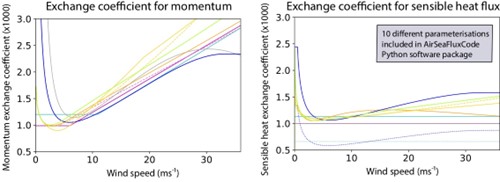
- New, open-access software developed by the National Oceanography Centre (NOC) brings together ten different formulae for calculating air-sea surface exchanges into one package for the very first time.
- The new software makes it easier to test the impacts of choosing one formula over another on the processes that drive the circulation patterns in the atmosphere and ocean, which dominate weather and climate.
- Supporting our goal to enable new understanding and insights across the scientific community, the academic paper, code and documentation are shared for free at the links below.
The ocean and atmosphere are very closely linked by their continual exchange of heat, moisture and momentum. These air-sea exchanges, or fluxes, play a major role in the Earth’s climate system and are important in making future projections of climate change. Measuring these air-sea fluxes directly is very expensive and difficult so instead scientists usually calculate them from other, easier to measure, meteorological parameters such as wind speed and air temperature. However, there are many different formulae available, and each gives a different estimate of the flux. Until now, scientists have had to either use code provided by the developer of a particular formula or write their own. This makes comparing the results from different formulae very time-consuming.

A study just published in Frontiers in Marine Science describes the new open-source ‘AirSeaFluxCode’ software package which will enable scientists to easily compare the flux results from ten different formulae for the first time. This will allow more comprehensive analyses of fluxes and will also make it easier to investigate the impact of choosing one formula rather than another on a wide range of physical processes, such as the development of storms over the ocean. Improved understanding of such processes may ultimately lead to more accurate climate models.
View the code and documentation
This work was funded by the National Environment Research Council (NERC) through ORCHESTRA/ENCORE and CLASS projects.